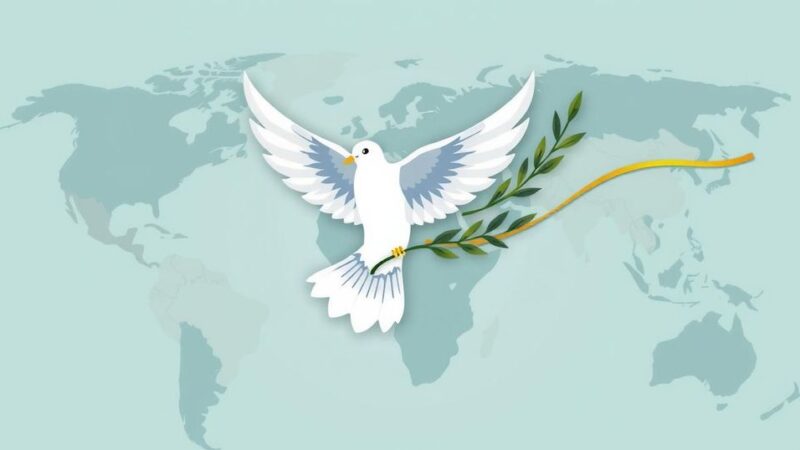President Trump has proposed creating a ‘freedom zone’ in Gaza amidst increasing Israeli airstrikes that have killed numerous Palestinians, including children. This controversial idea, which aims to displace Palestinians, has received outright rejection from Arab states and backlash from Hamas. While ceasefire talks have stalled, Trump’s Middle Eastern visit focuses on economic investments, but the crisis deepens as humanitarian access remains severely limited.
As the situation in Gaza continues to escalate, President Trump suggested on Thursday transforming the region into a “freedom zone.” This remark comes amidst intense airstrikes by Israel, which have reportedly killed over 150 people in one day, including many children. Trump’s proposal has faced widespread rejection from Arab nations, while Hamas has labeled it as ethnic cleansing. This plan to displace Palestinians is occurring even as ceasefire discussions appear to be at a standstill.
Currently in the Middle East, Trump’s travels have not included a visit to Israel, and he has largely avoided addressing the ongoing conflict in his public comments. However, he spoke to reporters after meeting with business leaders in Qatar, stating that Gaza has “been a territory of death and destruction for many years” and he believes there are better concepts for the region. His remarks have caused concern, considering the context of the high casualty figures reported from ongoing hostilities.
Reports indicate that the death toll of Palestinians in the conflict has surpassed a staggering 53,000, with a significant portion being children, according to the health ministry in Gaza. Hospitals have been overwhelmed with the influx of casualties due to Israeli airstrikes, which have reportedly intensified in recent days, leaving widespread destruction across the Strip.
Interestingly, a notable event took place just before Trump arrived – Hamas released a U.S.-Israeli hostage, Edan Alexander. This may have raised some hope for progress in ceasefire negotiations, as Hamas mentioned they reached an understanding with the Trump administration for Alexander’s release, which would entail humanitarian aid entering Gaza. They are calling for a permanent ceasefire and U.S. assurances that any remaining hostages would be part of a deal to end the conflict.
Despite this development, talks seem to have stalled recently, even with Israeli negotiators present in Qatar. Prime Minister Benjamin Netanyahu insists that any agreement would only be temporary and is keen to maintain military pressure on Hamas. His government is gearing up for further conflict, with plans to extend their control over additional territory in Gaza, which includes enlisting reservist soldiers for potential offensive actions.
During his stay in the Gulf, Trump engaged with regional leaders about the, uh, urgency of ending the war. The Saudi crown prince and Qatar’s ruling emir expressed their concerns directly to him. However, the Israeli government continues to prepare for military operations, including a controversial U.S.-backed plan to distribute food rations to displaced Palestinians, much to the dismay of aid organizations who fear this approach would exacerbate the crises faced by Gazans.
Israel has enforced a strict blockade on Gaza for more than two months, barring essential aid such as food, fuel, and medicine. This has led to a dire humanitarian crisis in which independent experts have highlighted that around half a million people are facing starvation. Global criticism of this blockade is growing, as international bodies and humanitarian groups advocate for lifting these restrictions to allow desperately needed aid into the region.
Trump’s trip has also focused heavily on economic initiatives, with discussions around significant investment deals taking center stage. For instance, Qatar signed a deal for up to 210 Boeing airplanes, while also showcasing technology and defense contracts during his earlier visit to Saudi Arabia. Despite his focus on business, Trump made headlines at Al-Udeid Air Base by addressing U.S. troops, where he reiterated false claims about the 2020 election and condemned the current administration as “evil.”
While his remarks were, you know, geared towards boosting troop morale, they also expressed a broader aim to mend and strengthen America’s posture in the region. Meanwhile, Trump’s interactions with regional leaders and comments on Gaza illustrate the complexities of foreign policy as violence continues to ravage the area and the prospects for peace remain bleak.
In summary, President Trump’s proposal to establish a “freedom zone” in Gaza has ignited significant backlash amid ongoing violence and a humanitarian crisis. With ceasefire talks at an impasse and the death toll in Gaza rising sharply, the situation remains precarious. As Trump emphasizes economic investments in the Middle East, the conflict’s human cost looms large, underscoring the urgent need for resolution and humanitarian aid access.
Original Source: health.wusf.usf.edu






